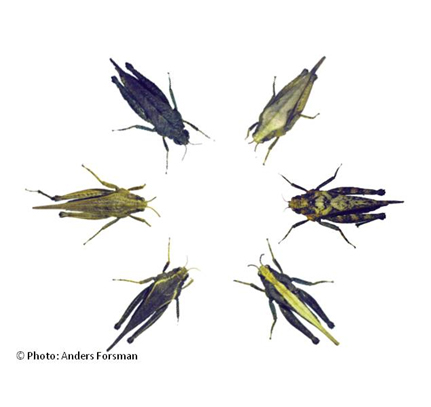There is strength in diversity!

Among individual variation exemplified by alternative colour morphs of the pygmy grasshopper Tetrix subulata (photograph by Anders Forsman)
A new study by researchers from Linnaeus University published in Ecography demonstrates that a higher degree of among individual variation is beneficial to populations and species. These results will allow for more efficient protection and restoration of biodiversity, the authors say.
It has been suggested that higher levels of phenotypic and genetic variation among individuals should promote the ecological and evolutionary success of populations and species in the face of environmental change, but this proposition has not previously been systematically evaluated.
Researchers from Linnaeus University in Sweden reviewed previous studies of plants, animals and bacteria to determine whether the predictions from theory are supported overall by results from experimental and phylogeny-based comparative investigations.
Lead author Professor Anders Forsman elaborates: “our review provides strong evidence that more variable populations are less vulnerable to environmental changes, show decreased fluctuations in population size, have superior establishment success, larger distribution ranges, and are less extinction prone, compared with less variable populations or species”.
A key finding is that variation is more beneficial if conditions are harsh. Study co-author Dr Lena Wennersten explains: “some of the experimental studies included in our review comprise two or more environmental treatments. These experiments indicate that the benefits of diversity are generally expressed more strongly under stressful than under benign conditions”.
The review also uncovered that the relationship linking benefits to diversity is more often linear than curvilinear. But there were exceptions to this pattern. Some studies point to the existence of an optimal level of diversity, and others suggest that the benefits of diversity follow the law of diminishing returns.
These consequences of variation are relevant for conservation work aimed at protection and restoration of biodiversity. For instance, the shape of the relationship that links diversity to population fitness informs how to best allocate conservation resources between competing needs, according to the authors.
The findings in the review align well with the notion that there is strength in diversity. However, the authors also identify important knowledge gaps and issues in need of future investigation. Anders Forsman concludes: “there is still ample opportunity for progress and new discoveries. We hope that our study will spur further interest in this rapidly growing and important area of research”.
Article:
Forsman, A. and Wennersten, L. 2015. Inter-individual variation promotes ecological success of populations and species: evidence from experimental and comparative studies. Ecography, DOI: 10.1111/ecog.01357
Contact information:
Anders Forsman, professor, e-mail: Anders.Forsman@LNU.se; phone: +46-(0)480-44 61 73; cellular phone: +46-(0)706-27 27 38
Lena Wennersten, PhD, e-mail: Lena.Wennersten@LNU.se; phone: +46-(0)480-44 62 27; cellular phone: +46-(0)733-26 18 51
Pressofficer Christina Dahlgren, +46-(0)470-70 85 51; cellular phone: +46-(0)70-572 26 56
Anders Forsman and Lena Wennersten are members of the Linnaeus University Centre for Ecology and Evolution in Microbial model Systems, EEMiS. http://lnu.se/lnuc/eemis
Anders Forsman’s personal webpage: http://lnu.se/personal/anders.forsman
http://onlinelibrary.wiley.com/doi/10.1111/ecog.01357/abstract Link to the article
Media Contact
All latest news from the category: Life Sciences and Chemistry
Articles and reports from the Life Sciences and chemistry area deal with applied and basic research into modern biology, chemistry and human medicine.
Valuable information can be found on a range of life sciences fields including bacteriology, biochemistry, bionics, bioinformatics, biophysics, biotechnology, genetics, geobotany, human biology, marine biology, microbiology, molecular biology, cellular biology, zoology, bioinorganic chemistry, microchemistry and environmental chemistry.
Newest articles

Machine learning algorithm reveals long-theorized glass phase in crystal
Scientists have found evidence of an elusive, glassy phase of matter that emerges when a crystal’s perfect internal pattern is disrupted. X-ray technology and machine learning converge to shed light…

Mapping plant functional diversity from space
HKU ecologists revolutionize ecosystem monitoring with novel field-satellite integration. An international team of researchers, led by Professor Jin WU from the School of Biological Sciences at The University of Hong…

Inverters with constant full load capability
…enable an increase in the performance of electric drives. Overheating components significantly limit the performance of drivetrains in electric vehicles. Inverters in particular are subject to a high thermal load,…





















